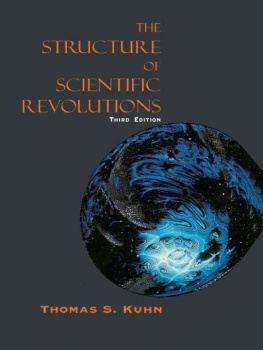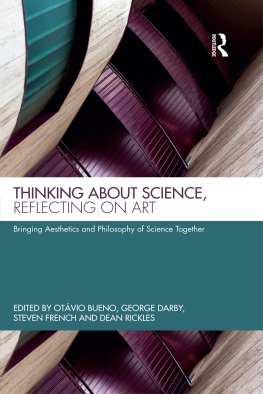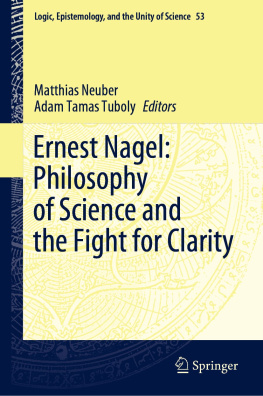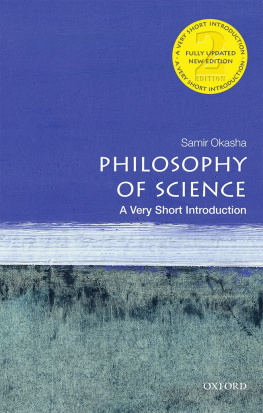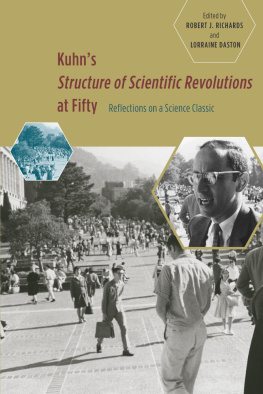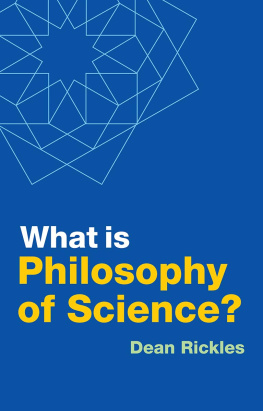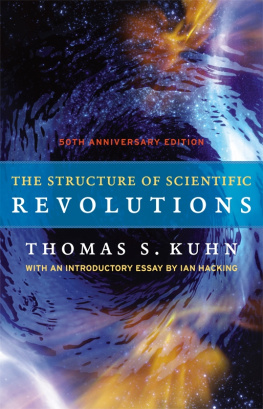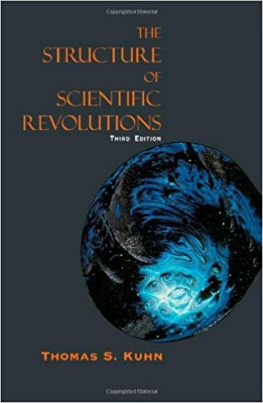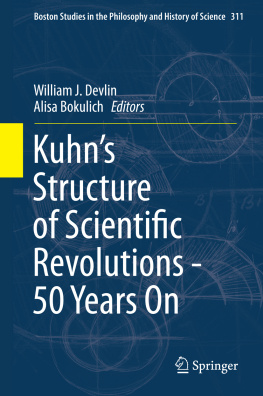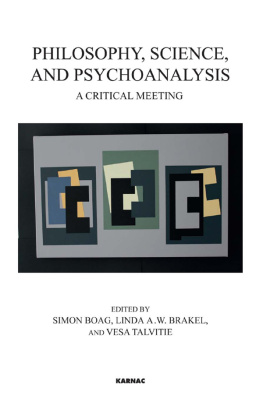Table of Contents
The University of Chicago Press, Chicago 60637
The University of Chicago Press, Ltd., London
1962, 1970, 1996 by The University of Chicago
All rights reserved.
Third edition 1996
Printed in the United States of America
05 04 03 02 01 00 345
ISBN: 0-226-45807-5 (cloth) ISBN: 0-226-45808-3 (paper)
Library of Congress Cataloging-in-Publication Data
Kuhn, Thomas S.
The structure of scientific revolutions / Thomas S. Kuhn. -- 3rd ed. p. cm.
Includes bibliographical references and index.
ISBN 0-226-45807-5 (cloth : alk. paper). ISBN 0-226-45808-3 (pbk. : alk.paper)
1. Science--Philosophy. 2. Science--History. I. Title.
Q175.K95 1996
501--dc20 96-13195
CIP

The paper used in this publication meets the minimum requirements of the American National Standard for Information SciencesPermanence of Paper for Printed Library Materials, ANSI Z39.48-1992.
Preface
The essay that follows is the first full published report on a project originally conceived almost fifteen years ago. At that time I was a graduate student in theoretical physics already within sight of the end of my dissertation. A fortunate involvement with an experimental college course treating physical science for the non-scientist provided my first exposure to the history of science. To my complete surprise, that exposure to out-of-date scientific theory and practice radically undermined some of my basic conceptions about the nature of science and the reasons for its special success.
Those conceptions were ones I had previously drawn partly from scientific training itself and partly from a long-standing avocational interest in the philosophy of science. Somehow, whatever their pedagogic utility and their abstract plausibility, those notions did not at all fit the enterprise that historical study displayed. Yet they were and are fundamental to many discussions of science, and their failures of verisimilitude therefore seemed thoroughly worth pursuing. The result was a drastic shift in my career plans, a shift from physics to history of science and then, gradually, from relatively straightforward historical problems back to the more philosophical concerns that had initially led me to history. Except for a few articles, this essay is the first of my published works in which these early concerns are dominant. In some part it is an attempt to explain to myself and to friends how I happened to be drawn from science to its history in the first place.
My first opportunity to pursue in depth some of the ideas set forth below was provided by three years as a Junior Fellow of the Society of Fellows of Harvard University. Without that period of freedom the transition to a new field of study would have been far more difficult and might not have been achieved. Part of my time in those years was devoted to history of science proper. In particular I continued to study the writings of Alexandre Koyr and first encountered those of Emile Meyerson, Hlne Metzger, and Anneliese Maier. More clearly than most other recent scholars, this group has shown what it was like to think scientifically in a period when the canons of scientific thought were very different from those current today. Though I increasingly question a few of their particular historical interpretations, their works, together with A. O. Lovejoys Great Chain of Being, have been second only to primary source materials in shaping my conception of what the history of scientific ideas can be.
Much of my time in those years, however, was spent exploring fields without apparent relation to history of science but in which research now discloses problems like the ones history was bringing to my attention. A footnote encountered by chance led me to the experiments by which Jean Piaget has illuminated both the various worlds of the growing child and the process of transition from one to the next. That is the sort of random exploration that the Society of Fellows permits, and only through it could I have encountered Ludwik Flecks almost unknown monograph, Entstehung und Entwicklung einer wis-senschaftlichen Tatsache (Basel, 1935), an essay that anticipates many of my own ideas. Together with a remark from another Junior Fellow, Francis X. Sutton, Flecks work made me realize that those ideas might require to be set in the sociology of the scientific community. Though readers will find few references to either these works or conversations below, I am indebted to them in more ways than I can now reconstruct or evaluate.
During my last year as a Junior Fellow, an invitation to lecture for the Lowell Institute in Boston provided a first chance to try out my still developing notion of science. The result was a series of eight public lectures, delivered during March, 1951, on The Quest for Physical Theory. In the next year I began to teach history of science proper, and for almost a decade the problems of instructing in a field I had never systematically studied left little time for explicit articulation of the ideas that had first brought me to it. Fortunately, however, those ideas proved a source of implicit orientation and of some problem-structure for much of my more advanced teaching. I therefore have my students to thank for invaluable lessons both about the viability of my views and about the techniques appropriate to their effective communication. The same problems and orientation give unity to most of the dominantly historical, and apparently diverse, studies I have published since the end of my fellowship. Several of them deal with the integral part played by one or another metaphysic in creative scientific research. Others examine the way in which the experimental bases of a new theory are accumulated and assimilated by men committed to an incompatible older theory. In the process they describe the type of development that I have below called the emergence of a new theory or discovery. There are other such ties besides.
The final stage in the development of this essay began with an invitation to spend the year 1958-59 at the Center for Advanced Studies in the Behavioral Sciences. Once again I was able to give undivided attention to the problems discussed below. Even more important, spending the year in a community composed predominantly of social scientists confronted me with unanticipated problems about the differences between such communities and those of the natural scientists among whom I had been trained. Particularly, I was struck by the number and extent of the overt disagreements between social scientists about the nature of legitimate scientific problems and methods. Both history and acquaintance made me doubt that practitioners of the natural sciences possess firmer or more permanent answers to such questions than their colleagues in social science. Yet, somehow, the practice of astronomy, physics, chemistry, or biology normally fails to evoke the controversies over fundamentals that today often seem endemic among, say, psychologists or sociologists. Attempting to discover the source of that difference led me to recognize the role in scientific research of what I have since called paradigms. These I take to be universally recognized scientific achievements that for a time provide model problems and solutions to a community of practitioners. Once that piece of my puzzle fell into place, a draft of this essay emerged rapidly.
The subsequent history of that draft need not be recounted here, but a few words must be said about the form that it has preserved through revisions. Until a first version had been completed and largely revised, I anticipated that the manuscript would appear exclusively as a volume in the Encyclopedia of Unified Science. The editors of that pioneering work had first solicited it, then held me firmly to a commitment, and finally waited with extraordinary tact and patience for a result. I am much indebted to them, particularly to Charles Morris, for wielding the essential goad and for advising me about the manuscript that resulted. Space limits of the Encyclopedia made it necessary, however, to present my views in an extremely condensed and schematic form. Though subsequent events have somewhat relaxed those restrictions and have made possible simultaneous independent publication, this work remains an essay rather than the full-scale book my subject will ultimately demand.

 The paper used in this publication meets the minimum requirements of the American National Standard for Information SciencesPermanence of Paper for Printed Library Materials, ANSI Z39.48-1992.
The paper used in this publication meets the minimum requirements of the American National Standard for Information SciencesPermanence of Paper for Printed Library Materials, ANSI Z39.48-1992.
